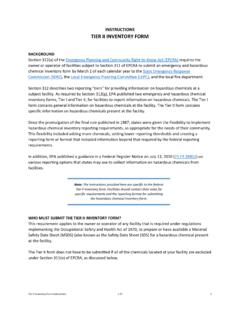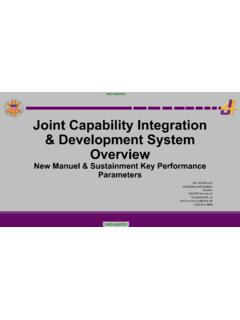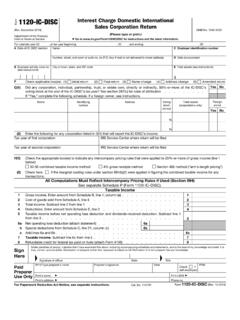Transcription of Chapter: 3 SARA Title III Sections 311 and 312 - Michigan
1 CHAPTER3 sara Title III Sections 311 & 312 Quick Look-up Guide Emergency & Hazardous ChemicalInventory Reporting Online Reporting in tier II Manager TMCHAPTER 3: sara Title III Sections 311 and 312 517-284- sara 3-1 Quick Look-up Guide Topic Page Number Who Must Submit the Hazardous Chemical Inventory Report? .. 3-3 What Hazardous Chemicals Are Included? .. 3-3 Physical and Health Hazards Reporting Thresholds Formula to Convert Gallons to Pounds .. 3-8 What Chemicals Are Excluded? .. 3-9 Hazardous Chemical Inventory 3-9 section 311 Initial Report section 312 Annual ( tier II) Report Where to Submit the Reports .. 3-10 Due Dates .. 3-10 Confidential and Trade Secret Information .. 3-11 Online Report Overview .. 3-11 Community Right-to-Know Provisions .. 3-12 Local Fire Department Requests .. 3-12 Online Reporting in tier II Manager.
2 3-13 Getting Started .. 3-13 Who Can Report Online Participating Counties The Administrator System Requirements Accessing tier II Manager .. 3-14 Website Location User Accounts Sign In Forgot your Username? Forgot your Password? Registration Consultants Online Reporting Process .. 3-17 Welcome Page and Update User Profile CHAPTER 3: sara Title III Sections 311 and 312 517-284- sara 3-2 Topic Page Number List Facilities .. 3-18 List Submissions .. 3-19 Add a New Report .. 3-19 Step 1: Review Facility Information .. 3-21 Step 2: Review Chemical Inventory .. 3-22 Mixture Example: Lead-Acid 3-26 Step 3: Review Subject to Status .. 3-27 Step 4: Review Report Contacts .. 3-28 Step 5: Review Attachments .. 3-29 Notes .. 3-29 Step 6: Submit Report .. 3-29 Final Step .. 3-30 Managing Reports and Data .. 3-30 Add New Facility Facility No Longer Required to File Facility Closed and Chemicals Removed Facility Moved Facility Sold or Purchased Ownership Change Inventory Updates Access to the Data and Reports.
3 3-31 Keeping Copies of the Reports .. 3-32 CHAPTER 3: sara Title III Sections 311 and 312 517-284- sara 3- 3 sara title iii sections 311 and 312 Emergency and Hazardous Chemical Inventory Reporting 40 Code of Federal Regulations (CFR) Part 370 Sections 311 and 312 of sara Title III address emergency and hazardous chemical inventory reporting. The implementing regulations are codified in 40 CFR Part 370. The regulations are intended to provide the public, local governments, fire departments, and other emergency officials with information concerning the potential chemical risks in their communities. Over 6,000 facilities in Michigan submit hazardous chemical inventories to the Michigan sara Title III Program, Local Emergency Planning Committees (LEPCs), and local fire departments. Who Must Submit the Hazardous Chemical Inventory Report?
4 These reporting requirements apply to any facility that must maintain a safety data sheet (SDS) in accordance with the Occupational Safety and Health Administration (OSHA) Hazard Communication Standard, 29 CFR The owner or operator must submit the hazardous chemical inventory report if a hazardous chemical present at the facility meets or exceeds the reporting threshold. Federal agencies were directed by Executive Order Number 12856, signed by President Clinton on August 3, 1993, to comply with all provisions of sara Title III and the Pollution Prevention Act. What Hazardous Chemicals Are Included? The criteria for including chemicals in the section 311 report are the same as the criteria for including chemicals in the section 312 ( tier II) report. Hazardous chemicals are those chemicals or substances stored or used in the work place for which OSHA requires employers to maintain SDSs.
5 Over 650,000 products have SDS required by OSHA. They are referred to here as OSHA hazardous chemicals. There is no list of these OSHA hazardous chemicals. The OSHA hazardous chemicals must have an associated physical and/or health hazard as defined in the OSHA regulations in 29 CFR (c). Note: The Hazard Communication Standard requires chemical manufacturers, distributors, or importers to provide SDS (formerly known as Material Safety Data Sheets or MSDS ) to communicate the hazards of hazardous chemical products. As of June 1, 2015, new SDS must be in a uniform format. Michigan s Hazardous Chemical Inventory website: Select sara Title III - Hazardous Chemical Inventory 517-284- sara (517-284-7272) If your facility is not covered by OSHA, reports are not required. However, in the interest of emergency preparedness, you are urged to consider reporting all hazardous substances that meet or exceed the reporting thresholds.
6 CHAPTER 3: sara Title III Sections 311 and 312 517-284- sara 3-4 Physical and Health Hazards The physical and health hazards will be described in the SDS. Check your SDS to see if the substance has associated physical and/or health hazards. If the SDS does not clearly describe the hazards, contact the manufacturer or importer of the substance for clarification. It is their responsibility to determine the hazards in accordance with OSHA standards and provide that information in the SDS. Some non-hazardous substances such as water can also have SDSs. If a substance is not hazardous according to the OSHA definition, the SDS should state that there are no known hazards. Be aware that manufacturers sometimes claim in the SDS that a hazardous substance is not hazardous to avoid additional handling costs. Regardless of what is in the SDS, such substances must be included in the hazardous chemical inventory.
7 The EPA recently issued revisions to 40 CFR Part 370 that will affect reporting under Sections 311 and 312 of the Emergency Planning and Community Right to Know Act (EPCRA) for the 2017 calendar year. The revisions are intended to better align EPCRA with the revised OSHA Hazard Communication Standard (HCS) and facilitate safer management of hazardous materials. To align with the revised physical and health hazards in OSHA s HCS, EPA has revised the hazard categories in 40 CFR Part 370. Instead of continuing to use the current five hazard categories (Fire, Sudden Release of Pressure, Reactive, Immediate (Acute) health hazard, Delayed (Chronic) health hazard), EPA is adopting the 24 hazards used in the revised OSHA HCS, which are listed in the following table: Physical and Health Hazards (to be effective January 1, 2018) Facilities submitting tier II reports by March 1, 2018 for the 2017 calendar year will need to use the new EPCRA hazard categories.
8 Michigan s tier II Manager program has been updated to accommodate the new standard. Facilities moving forward will need to check all physical and health hazards that apply to their chemical(s) in tier II Manager (see instructions below). CHAPTER 3: sara Title III Sections 311 and 312 517-284- sara 3-5 Detailed Description of Changes to Hazard Categories for Reporting Under Sections 311 and 312 Coming in 2018 The final rule outlined below will be effective on January 1, 2018. This means that by March 1st, 2018, facilities are required to report the revised physical and health hazards (see tables below) for their hazardous chemicals present during 2017 calendar year. These changes will be in effect in the Michigan tier II Manager program in time for the 2018 reporting year. This final rule revises the hazard categories in the regulations at 40 CFR Part 370, for reporting under Sections 311 and 312 of the Emergency Planning and Community Right-To-Know Act (EPCRA).
9 On March 26th, 2012, OSHA revised its Hazard Communication Standard (HCS) by adopting the United Nations Globally Harmonization System of Classification and Labeling of Chemicals (GHS). The changes to OSHA s HCS affect the reporting requirements under Sections 311 and 312 of the EPCRA. What are the reporting requirements of the EPCRA Sections 311 and 312? Sections 311 and 312 of the EPCRA contain provisions for hazardous chemical inventory reporting. Facilities that handle hazardous chemicals defined under the Occupational Safety and Health Act of 1970 and its implementing regulations must provide information on the quantity, locations, and the potential hazards of these chemicals. This information is submitted to the State Emergency Response Commission (SERC) or Tribal Emergency Response Commission (TERC), Local Emergency Planning Committee (LEPC) or Tribal Emergency Planning Committee (TEPC), and the fire department.
10 section 311 requires facilities to submit the SDSs of hazardous chemicals present at or above the reporting thresholds specified in the regulations at 40 CFR Part 370. Facilities may also submit a list of hazardous chemicals grouped into hazard categories, instead of the SDSs. section 312 requires these facilities to submit the hazardous chemical inventory form to their SERC (or TERC), LEPC (or TEPC), and the fire department by March 1, annually. The inventory form provides the physical and/or health hazard of each hazardous chemical, their locations, and quantities that were present at the facility during the previous calendar year. What is the Background of this Final Rule? The statute specifies that the list of hazardous chemicals reported under section 311 and the inventory forms reported under section 312 should be based on the physical and health hazards established under OSHA and its implementing regulations.

















